- See also: List of bilateral animal orders
This timeline of the evolutionary history of life represents the current scientific theory outlining the major events during the development of life on planet Earth. In biology, evolution is any change across successive generations in the heritable characteristics of biological populations. Evolutionary processes give rise to diversity at every level of biological organization, from kingdoms to species, and individual organisms and molecules, such as DNA and proteins. The similarities between all present day organisms indicate the presence of a common ancestor from which all known species, living and extinct, have diverged through the process of evolution. More than 99 percent of all species, amounting to over five billion species, that ever lived on Earth are estimated to be extinct. Estimates on the number of Earth's current species range from 10 million to 14 million, of which about 1.2 million have been documented and over 86 percent have not yet been described. However, a May 2016 scientific report estimates that 1 trillion species are currently on Earth, with only one-thousandth of one percent described.
While the dates given in this article are estimates based on scientific evidence, there has been controversy between more traditional views of increased biodiversity through a cone of diversity with the passing of time and the view that the basic pattern on Earth has been one of annihilation and diversification and that in certain past times, such as the Cambrian explosion, there was great diversity.
In this timeline, Ma (for megaannum) means "million years ago," ka (for kiloannum) means "thousand years ago," and ya means "years ago."
Hadean Eon[]

- Main articles: Hadean
4000 Ma and earlier.
| Date | Event |
|---|---|
| 4600 Ma | The planet Earth forms from the accretion disc revolving around the young Sun with organic compounds (complex organic molecules) necessary for life having perhaps formed in the protoplanetary disk of cosmic dust grains surrounding it before the formation of the Earth. |
| 4500 Ma | According to the giant impact hypothesis, the Moon was formed when the planet Earth and the hypothesized planet Theia collided, sending a very large number of moonlets into orbit around the young Earth which eventually coalesced to form the Moon. The gravitational pull of the new Moon stabilised the Earth's fluctuating axis of rotation and set up the conditions in which abiogenesis occurred. |
| 4404 Ma | First appearance of liquid water on Earth. |
| 4280 Ma | Earliest possible appearance of life on Earth. |
Archean Eon[]
- Main articles: Archean

Fragment of the Acasta Gneiss exhibited at the Museum of Natural History in Vienna
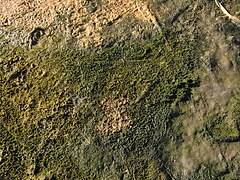
The cyanobacterial-algal mat, salty lake on the White Sea seaside

Halobacterium sp. strain NRC-1
4000 Ma – 2500 Ma
| Date | Event |
|---|---|
| 4000 Ma | Formation of a greenstone belt of the Acasta Gneiss of the Slave craton in Northwest Territories, Canada, the oldest rock belt in the world. |
| 4100–3800 Ma | Late Heavy Bombardment (LHB): extended barrage of impact events upon the inner planets by meteoroids. Thermal flux from widespread hydrothermal activity during the LHB may have been conducive to abiogenesis and life's early diversification. "Remains of biotic life" were found in 4.1 billion-year-old rocks in Western Australia. This is when life most likely arose. |
| 3900–2500 Ma | Cells resembling prokaryotes appear. These first organisms are chemoautotrophs: they use carbon dioxide as a carbon source and oxidize inorganic materials to extract energy. Later, prokaryotes evolve glycolysis, a set of chemical reactions that free the energy of organic molecules such as glucose and store it in the chemical bonds of ATP. Glycolysis (and ATP) continue to be used in almost all organisms, unchanged, to this day. |
| 3800 Ma | Formation of a greenstone belt of the Isua complex of the western Greenland region, whose rocks show an isotope frequency suggestive of the presence of life. The earliest evidences for life on Earth are 3.8 billion-year-old biogenic hematite in a banded iron formation of the Nuvvuagittuq Greenstone Belt in Canada, graphite in 3.7 billion-year-old metasedimentary rocks discovered in western Greenland and microbial mat fossils found in 3.48 billion-year-old sandstone discovered in Western Australia. |
| 3500 Ma | Lifetime of the last universal common ancestor (LUCA); the split between bacteria and archaea occurs.
Bacteria develop primitive forms of photosynthesis which at first did not produce oxygen. These organisms generated Adenosine triphosphate (ATP) by exploiting a proton gradient, a mechanism still used in virtually all organisms. |
| 3200 Ma | Diversification and expansion of acritarchs. |
| 3000 Ma | Photosynthesizing cyanobacteria evolved; they used water as a reducing agent, thereby producing oxygen as a waste product. The oxygen initially oxidizes dissolved iron in the oceans, creating iron ore. The oxygen concentration in the atmosphere slowly rose, acting as a poison for many bacteria and eventually triggering the Great Oxygenation Event. The Moon, still very close to Earth, caused tides 1,000 feet (305 m) high. The Earth was continually wracked by hurricane-force winds. These extreme mixing influences are thought to have stimulated evolutionary processes. |
| 2800 Ma | Oldest evidence for microbial life on land in the form of organic matter-rich paleosols, ephemeral ponds and alluvial sequences, some of them bearing microfossils. |
Proterozoic Eon[]
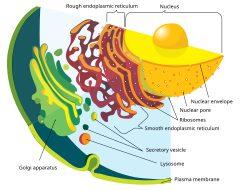
Detail of the eukaryote endomembrane system and its components

Dinoflagellate Ceratium furca
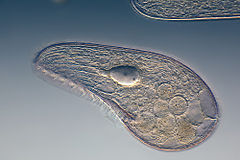
Blepharisma japonicum, a free-living ciliated protozoan

Dickinsonia costata, an iconic Ediacaran organism, displays the characteristic quilted appearance of Ediacaran enigmata.
- Main articles: Proterozoic
2500 Ma – 542 Ma. Contains the Palaeoproterozoic, Mesoproterozoic and Neoproterozoic eras.
| Date | Event |
|---|---|
| 2500 Ma | Great Oxygenation Event led by cyanobacteria's oxygenic photosynthesis. Commencement of plate tectonics with old marine crust dense enough to subduct. |
| By 1850 Ma | Eukaryotic cells appear. Eukaryotes contain membrane-bound organelles with diverse functions, probably derived from prokaryotes engulfing each other via phagocytosis. (See Symbiogenesis and Endosymbiont). Bacterial viruses (bacteriophage) emerge before, or soon after, the divergence of the prokaryotic and eukaryotic lineages. The appearance of red beds show that an oxidising atmosphere had been produced. Incentives now favoured the spread of eukaryotic life. |
| 1400 Ma | Great increase in stromatolite diversity. |
| 1300 Ma | Earliest land fungi |
| By 1200 Ma | Meiosis and sexual reproduction are present in single-celled eukaryotes, and possibly in the common ancestor of all eukaryotes. Sex may even have arisen earlier in the RNA world. Sexual reproduction first appears in the fossil records; it may have increased the rate of evolution. |
| 1 bya | The first non-marine eukaryotes move onto land. They were photosynthetic and multicellular, indicating that plants evolved much earlier than originally thought. |
| 750 Ma | First protozoa (ex: Melanocyrillium) |
| 850–630 Ma | A global glaciation may have occurred. Opinion is divided on whether it increased or decreased biodiversity or the rate of evolution. It is believed that this was due to evolution of the first land plants, which increased the amount of oxygen and lowered the amount of carbon dioxide in the atmosphere. |
| 600 Ma | The accumulation of atmospheric oxygen allows the formation of an ozone layer. Prior to this, land-based life would probably have required other chemicals to attenuate ultraviolet radiation enough to permit colonisation of the land. |
| 580–542 Ma | The Ediacara biota represent the first large, complex aquatic multicellular organisms — although their affinities remain a subject of debate. |
| 580–500 Ma | Most modern phyla of animals begin to appear in the fossil record during the Cambrian explosion. |
| 550 Ma | First fossil evidence for Ctenophora (comb jellies), Porifera (sponges), Anthozoa (corals and sea anemones) |
Phanerozoic Eon[]
- Main articles: Phanerozoic
542 Ma – present
The Phanerozoic Eon, literally the "period of well-displayed life," marks the appearance in the fossil record of abundant, shell-forming and/or trace-making organisms. It is subdivided into three eras, the Paleozoic, Mesozoic and Cenozoic, which are divided by major mass extinctions.
Palaeozoic Era[]
- Main articles: Paleozoic
542 Ma – 251.0 Ma and contains the Cambrian, Ordovician, Silurian, Devonian, Carboniferous and Permian periods.

With only a handful of species surviving today, the Nautiloids flourished during the early Paleozoic era, from the Late Cambrian, where they constituted the main predatory animals.

Haikouichthys, a jawless fish, is popularized as one of the earliest fishes and probably a basal chordate or a basal craniate.

Ferns first appear in the fossil record about 360 million years ago in the late Devonian period.
| Date | Event |
|---|---|
| 535 Ma | Major diversification of living things in the oceans: chordates, arthropods (e.g. trilobites, crustaceans), echinoderms, molluscs, brachiopods, foraminifers and radiolarians, etc. |
| 530 Ma | The first known footprints on land date to 530 Ma. |
| 525 Ma | Earliest graptolites |
| 510 Ma | First cephalopods (nautiloids) and chitons |
| 505 Ma | Fossilization of the Burgess Shale |
| 485 Ma | First vertebrates with true bones (jawless fishes) |
| 450 Ma | First complete conodonts and echinoids appear |
| 440 Ma | First agnathan fishes: Heterostraci, Galeaspida, and Pituriaspida |
| 420 Ma | Earliest ray-finned fishes, trigonotarbid arachnids, and land scorpions |
| 410 Ma | First signs of teeth in fish. Earliest Nautilida, lycophytes, and trimerophytes. |
| 395 Ma | First lichens, stoneworts. Earliest harvestmen, mites, hexapods (springtails) and ammonoids. The first known tetrapod tracks on land. |
| 363 Ma | By the start of the Carboniferous Period, the Earth begins to resemble its present state. Insects roamed the land and would soon take to the skies; sharks swam the oceans as top predators, and vegetation covered the land, with seed-bearing plants and forests soon to flourish.
Four-limbed tetrapods gradually gain adaptations which will help them occupy a terrestrial life-habit. |
| 360 Ma | First crabs and ferns. Land flora dominated by seed ferns. |
| 350 Ma | First large sharks, ratfishes, and hagfish |
| 340 Ma | Diversification of amphibians |
| 330 Ma | First amniote vertebrates (Paleothyris) |
| 320 Ma | Synapsids (precursors to mammals) separate from sauropsids (reptiles) in late Carboniferous. |
| 305 Ma | Earliest diapsid reptiles (e.g. Petrolacosaurus) |
| 280 Ma | Earliest beetles, seed plants and conifers diversify while lepidodendrids and sphenopsids decrease. Terrestrial temnospondyl amphibians and pelycosaurs (e.g. Dimetrodon) diversify in species. |
| 275 Ma | Therapsid synapsids separate from pelycosaur synapsids |
| 251.4 Ma | The Permian–Triassic extinction event eliminates over 90-95% of marine species. Terrestrial organisms were not as seriously affected as the marine biota. This "clearing of the slate" may have led to an ensuing diversification, but life on land took 30 million years to completely recover. |
Mesozoic Era[]
- Main articles: Mesozoic
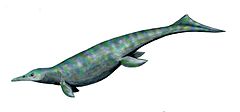
Utatsusaurus is the earliest-known form of an ichthyopterygian.

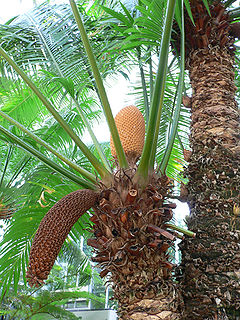
From 251.4 Ma to 66 Ma and containing the Triassic, Jurassic and Cretaceous periods.
| Date | Event |
|---|---|
| The Mesozoic Marine Revolution begins: increasingly well adapted and diverse predators pressurize sessile marine groups; the "balance of power" in the oceans shifts dramatically as some groups of prey adapt more rapidly and effectively than others. | |
| 248 Ma | Sturgeon and paddlefish (Acipenseridae) first appear. |
| 245 Ma | Earliest ichthyosaurs |
| 240 Ma | Increase in diversity of gomphodont cynodonts and rhynchosaurs |
| 225 Ma | Earliest dinosaurs (prosauropods), first cardiid bivalves, diversity in cycads, bennettitaleans, and conifers. First teleost fishes. First mammals (Adelobasileus). |
| 220 Ma | Seed-producing Gymnosperm forests dominate the land; herbivores grow to huge sizes to accommodate the large guts necessary to digest the nutrient-poor plants. First flies and turtles (Odontochelys). First coelophysoid dinosaurs. |
| 205
Ma |
the Massive extinction of Triassic/Jurassic, that wiped out most of the group of pseudosuchians and was given the opportunity of dinosaurs including the Apatosaurus, Tyrannosaurus, Perrotasaurus, and Stegosaurus to enter its golden age. |
| 200 Ma | The first accepted evidence for viruses that infect eukaryotic cells (at least, the group Geminiviridae) existed. Viruses are still poorly understood and may have arisen before "life" itself, or may be a more recent phenomenon.
Major extinctions in terrestrial vertebrates and large amphibians. Earliest examples of armoured dinosaurs |
| 195 Ma | First pterosaurs with specialized feeding (Dorygnathus). First sauropod dinosaurs. Diversification in small, ornithischian dinosaurs: heterodontosaurids, fabrosaurids, and scelidosaurids. |
| 190 Ma | Pliosauroids appear in the fossil record. First lepidopteran insects (Archaeolepis), hermit crabs, modern starfish, irregular echinoids, corbulid bivalves, and tubulipore bryozoans. Extensive development of sponge reefs. |
| 176 Ma | First members of the Stegosauria group of dinosaurs |
| 170 Ma | Earliest salamanders, newts, cryptoclidids, elasmosaurid plesiosaurs, and cladotherian mammals. Sauropod dinosaurs diversify. |
| 165 Ma | First rays and glycymeridid bivalves |
| 163 Ma | Pterodactyloid pterosaurs first appear |
| 161 Ma | Ceratopsian dinosaurs appear in the fossil record (Yinlong) and the oldest known Eutherian Mammal appear in the fossil record: Juramaia. |
| 160 Ma | Multituberculate mammals (genus Rugosodon) appear in eastern China |
| 155 Ma | First blood-sucking insects (ceratopogonids), rudist bivalves, and cheilostome bryozoans. Archaeopteryx, a possible ancestor to the birds, appears in the fossil record, along with triconodontid and symmetrodont mammals. Diversity in stegosaurian and theropod dinosaurs. |
| 130 Ma | The rise of the angiosperms: Some of these flowering plants bear structures that attract insects and other animals to spread pollen;other angiosperms were pollinated by wind or water. This innovation causes a major burst of animal evolution through coevolution. First freshwater pelomedusid turtles. |
| 120 Ma | Oldest fossils of heterokonts, including both marine diatoms and silicoflagellates |
| 115 Ma | First monotreme mammals |
| 110 Ma | First hesperornithes, toothed diving birds. Earliest limopsid, verticordiid, and thyasirid bivalves. |
| 106 Ma | Spinosaurus, the largest theropod dinosaur, appears in the fossil record |
| 100 Ma | Earliest bees |
| 90 Ma | Extinction of ichthyosaurs. Earliest snakes and nuculanid bivalves. Large diversification in angiosperms: magnoliids, rosids, hamamelidids, monocots, and ginger. Earliest examples of ticks. Probable origins of placental mammals (earliest undisputed fossil evidence is 66 Ma). |
| 80 Ma | First ants |
| 70 Ma | Multituberculate mammals increase in diversity. First yoldiid bivalves. |
| 68 Ma | Tyrannosaurus, the largest terrestrial predator of what is now western North America appears in the fossil record. First species of Triceratops. |
Cenozoic Era[]
- Main articles: Cenozoic
66 Ma – present

Mount of oxyaenid Patriofelis from the American Museum of Natural History

The bat Icaronycteris appeared 52.2 million years ago
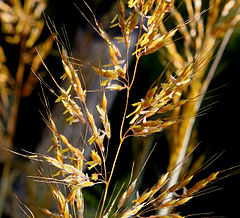
Grass flowers
| Date | Event |
|---|---|
| 66 Ma | The Cretaceous–Paleogene extinction event eradicates about half of all animal species, including mosasaurs, pterosaurs, plesiosaurs, ammonites, belemnites, rudist and inoceramid bivalves, most planktic foraminifers, and all of the dinosaurs excluding the birds. |
| From 66 Ma | Rapid dominance of conifers and ginkgos in high latitudes, along with mammals becoming the dominant species. First psammobiid bivalves. Earliest rodents. Rapid diversification in ants. |
| 63 Ma | Evolution of the creodonts, an important group of meat-eating (carnivorous) mammals |
| 60 Ma | Diversification of large, flightless birds. Earliest true primates, along with the first semelid bivalves, edentate, carnivoran and lipotyphlan mammals, and owls. The ancestors of the carnivorous mammals (miacids) were alive. |
| 56 Ma | Gastornis, a large flightless bird, appears in the fossil record |
| 55 Ma | Modern bird groups diversify (first song birds, parrots, loons, swifts, woodpeckers), first whale (Himalayacetus), earliest lagomorphs, armadillos, appearance of sirenian, proboscidean, perissodactyl and artiodactyl mammals in the fossil record. Angiosperms diversify. The ancestor (according to theory) of the species in the genus Carcharodon, the early mako shark Isurus hastalis, is alive. |
| 52 Ma | First bats appear (Onychonycteris) |
| 50 Ma | Peak diversity of dinoflagellates and nannofossils, increase in diversity of anomalodesmatan and heteroconch bivalves, brontotheres, tapirs, rhinoceroses, and camels appear in the fossil record, diversification of primates |
| 40 Ma | Modern-type butterflies and moths appear. Extinction of Gastornis. Basilosaurus, one of the first of the giant whales, appeared in the fossil record. |
| 37 Ma | First nimravid ("false saber-toothed cats") carnivores — these species are unrelated to modern-type felines |
| 35 Ma | Grasses diversify from among the monocot angiosperms; grasslands begin to expand. Slight increase in diversity of cold-tolerant ostracods and foraminifers, along with major extinctions of gastropods, reptiles, amphibians, and multituberculate mammals. Many modern mammal groups begin to appear: first glyptodonts, ground sloths, canids, peccaries, and the first eagles and hawks. Diversity in toothed and baleen whales. |
| 33 Ma | Evolution of the thylacinid marsupials (Badjcinus) |
| 30 Ma | First balanids and eucalypts, extinction of embrithopod and brontothere mammals, earliest pigs and cats |
| 28 Ma | Paraceratherium appears in the fossil record, the largest terrestrial mammal that ever lived |
| 25 Ma | Pelagornis sandersi appears in the fossil record, the largest flying bird that ever lived |
| 25 Ma | First deer |
| 20 Ma | First giraffes, hyenas, bears and giant anteaters, increase in bird diversity |
| 15 Ma | Genus Mammut appears in the fossil record, first bovids and kangaroos, diversity in Australian megafauna |
| 10 Ma | Grasslands and savannas are established, diversity in insects, especially ants and termites, horses increase in body size and develop high-crowned teeth, major diversification in grassland mammals and snakes |
| 9.5 Ma | The Great American Interchange, where various land and freshwater faunas migrated between North and South America. Armadillos, opossums, hummingbirds Phorusrhacids, Ground Sloths, Glyptodonts, and Meridiungulates traveled to North America, while horses, tapirs, saber-toothed cats, Jaguars, Bears, Coaties, Ferrets, Otters, Skunks and deer entered South America. |
| 6.5 Ma | First hominins (Sahelanthropus) |
| 6 Ma | Australopithecines diversify (Orrorin, Ardipithecus) |
| 5 Ma | First tree sloths and hippopotami, diversification of grazing herbivores like zebras and elephants, large carnivorous mammals like lions and the genus Canis, burrowing rodents, kangaroos, birds, and small carnivores, vultures increase in size, decrease in the number of perissodactyl mammals. Extinction of nimravid carnivores. |
| 4.8 Ma | Mammoths appear in the fossil record |
| 4 Ma | Evolution of Australopithecus, Stupendemys appears in the fossil record as the largest freshwater turtle, first modern elephants, giraffes, zebras, lions, rhinoceros and gazelles appear in the fossil record |
| 2.7 Ma | Evolution of Paranthropus |
| 2.5 Ma | The earliest species of Smilodon evolve |
| 2 Ma | First members of the genus Homo, Homo Habilis, appear in the fossil record. Diversification of conifers in high latitudes. The eventual ancestor of cattle, aurochs (Bos primigenus), evolves in India. |
| 1.7 Ma | Extinction of australopithecines |
| 1.2 Ma | Evolution of Homo antecessor. The last members of Paranthropus die out. |
| 800 Ka | Short-faced bears (Arctodus simus) become abundant in North America |
| 600 ka | Evolution of Homo heidelbergensis |
| 350 ka | Evolution of Neanderthals |
| 300 ka | Gigantopithecus, a giant relative of the orangutan from Asia dies out |
| 250 ka | Anatomically modern humans appear in Africa. Around 50,000 years before present they start colonising the other continents, replacing the Neanderthals in Europe and other hominins in Asia. |
| 40 ka | The last of the giant monitor lizards (Varanus priscus) die out |
| 30 ka | Extinction of Neanderthals, first domestic dogs |
| 15 ka | The last woolly rhinoceros (Coelodonta antiquitatis) are believed to have gone extinct |
| 11 ka | Short-faced bears vanish from North America, with the last giant ground sloths dying out. All Equidae become extinct in North America. |
| 10 ka | The Holocene epoch starts 10,000 years ago after the Late Glacial Maximum. The last mainland species of woolly mammoth (Mammuthus primigenus) die out, as does the last Smilodon species. |
| 8 ka | The Giant Lemur died out |
Historical extinctions[]
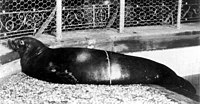

Illustration of a Baiji, declared functionally extinct by the Baiji.org Foundation in 2006.

Western black rhinoceros, holotype specimen of a female shot in 1911
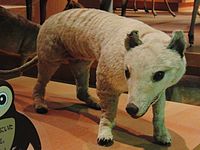
Thylacine shot in 1936
| Date | Event |
|---|---|
| 6000 ya (c. 4000 BC) | Small populations of American mastodon die off in places like Utah and Michigan |
| 4500 ya (c. 2500 BC) | The last members of a dwarf race of woolly mammoths vanish from Wrangel Island near Alaska |
| c. 600 ya (c. 1400) | The moa and its predator, Haast's eagle, die out in New Zealand |
| 397 ya (1627) | The last recorded wild aurochs die out |
| 336 ya (1688) | The dodo goes extinct |
| 256 ya (1768) | The Steller's sea cow goes extinct |
| 141 ya (1883) | The quagga, a subspecies of zebra, goes extinct |
| 110 ya (1914) | Martha, last known passenger pigeon, dies |
| 88 ya (1936) | The thylacine goes extinct in a Tasmanian zoo, the last member of the family Thylacinidae |
| 72 ya (1952) | The Caribbean monk seal goes extinct |
| 16 ya (2008) | The baiji, the Yangtze river dolphin, becomes functionally extinct, according to the IUCN Red List |
| 13 ya (2011) | The western black rhinoceros is declared extinct |
References[]

|
This page uses content that though originally imported from the Wikipedia article Timeline of the evolutionary history of life might have been very heavily modified, perhaps even to the point of disagreeing completely with the original wikipedia article. The list of authors can be seen in the page history. The text of Wikipedia is available under the Creative Commons Licence. |